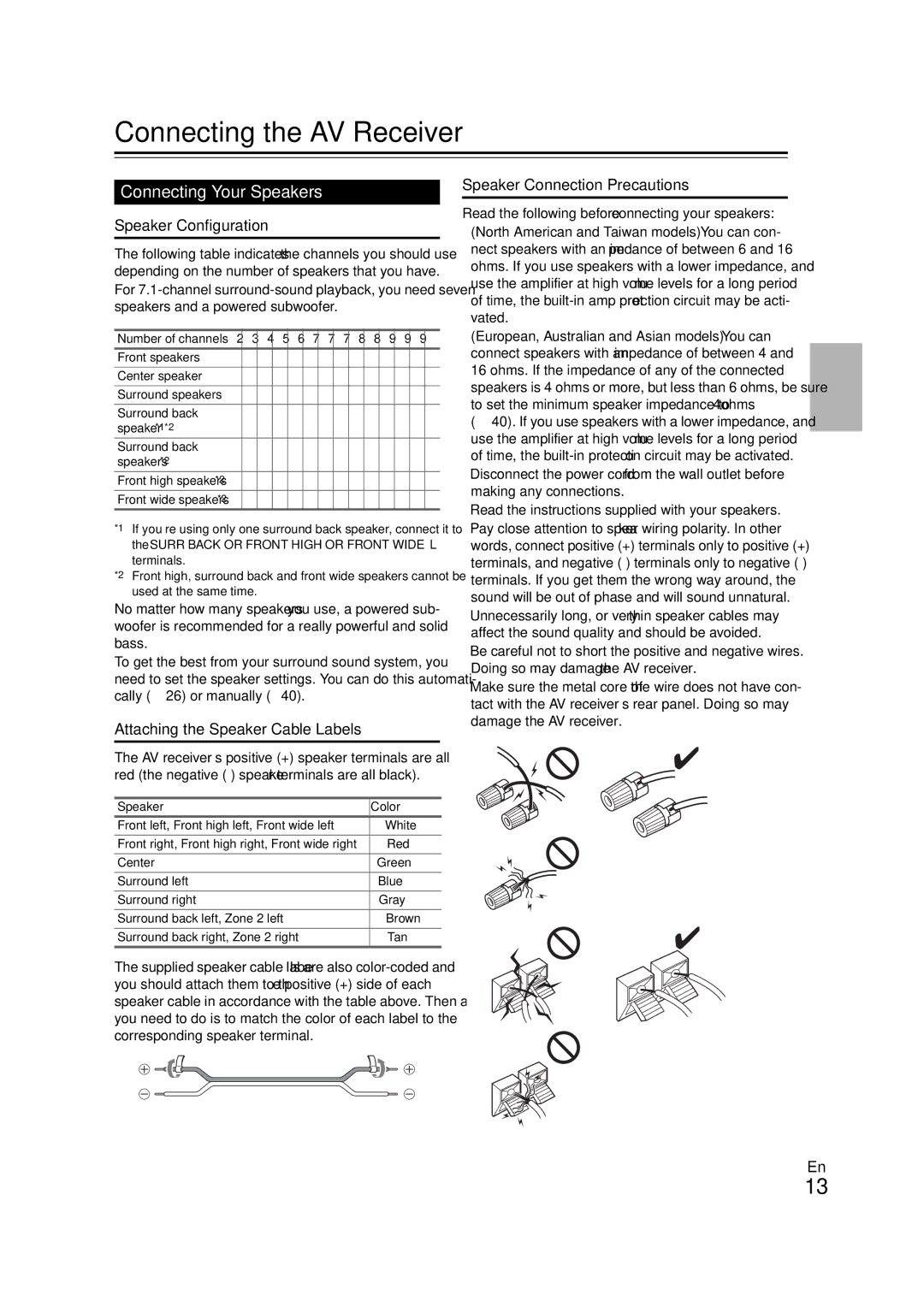TX-SR608
10 cm 4 at the rear. The rear edge of the shelf or
Always consider the environmental issues and follow
Board above the apparatus shall be set 10 cm
Away from the rear panel or wall, creating a flue-like
Precautions
Using the Remote Controller
Supplied Accessories
Installing the Batteries
Aiming the Remote Controller
Contents
Amplifier
Features
Processing
Miscellaneous
THX Select2 Plus
Front Panel
Front & Rear Panels
For detailed information, see the pages in parentheses
Display
UREMOTE Control jack
Power cord
Rear Panel
CENTER, FRONT, SURR, Surr Back or Front High or Front Wide
Controlling the AV Receiver
Remote Controller
Return button
Controlling the tuner
Enjoying Home Theater
About Home Theater
Connecting Your Speakers
Connecting the AV Receiver
Speaker Configuration
Speaker Connection Precautions
Speaker cables, and twist the bare wires tightly, as shown
Connecting the Speaker Cables
Screw-type speaker terminals Strip 1/2 to 5/8 12 to 15 mm
North American and Taiwan models Surround
Connecting a Powered Subwoofer
Using Dipole Speakers
Bi-amping the Front Speakers
Connected image with AV components
About AV Connections
AV Cables and Jacks
Hdmi cable
Jack Signal Components Assignable
Connecting Components with Hdmi
Audio return channel ARC function
Front
Connecting External Components
How to record the video
Connecting Antenna
Connecting Onkyo uComponents
System On/Auto Power On
Remote Control
Which Connections Should I Use?
Signal Selection
Video Connection Formats
Audio Connection Formats
Turning On
Turning On/Off the AV Receiver
Turning Off
Setting the Display Brightness
Selecting the Language Used for the Onscreen Setup Menus
Basic Operations
Playing the Connected Component
Using the Sleep Timer
Muting the AV Receiver Using the Home Menu
Selecting Speaker Layout
TV, MUSIC, GAME, and THX
Audyssey 2EQ Room Correction and Speaker Setup
Using Headphones
Changing the Input Display
Enter
Using Audyssey 2EQ
Changing the Speaker Settings Manually
Error Messages
Using a Powered Subwoofer
Tuning into Radio Stations
Using the Tuner
Listening to the Radio
Listening to the Radio
Using RDS excluding North American models
Presetting FM/AM Stations
Listening to Traffic News TP
Finding Stations by Type PTY
RDS program types PTY
Recording
Connecting a Recording Component
Recording Separate AV Sources
AV Recording
Listening Mode Buttons
Using the Listening Modes
Selecting Listening Modes
Explanatory Notes
About Listening Modes
Input Source
Speaker Layout
Listening Modes
DTS-HD Master
Resolution Audio
DSD *7
DTS 96/24 *8
Listening Mode Description Input Speaker Source Layout
Onkyo-Original DSP Listening Modes
On-screen Setup Menus
Advanced Setup
Common Procedures in Setup Menu
Menu
Monitor Out
Input/Output Assign
Hdmi Input
BD/DVD, VCR/DVR, CBL/SAT, GAME, PC, TV/CD, Port
Speaker Settings
Speaker Setup
Component Video Input
Digital Audio Input
Speaker Terminal Assign Front High/Front Wide/Zone2
Speakers Type
SurrBack/Front High/Front Wide
Front
Speaker Distance
Equalizer Settings
Level Calibration
BGC
THX Audio Setup
Multiplex/Mono
Audio Adjust
Dolby
Theater-Dimensional
Source Setup
Audyssey DSX
LFE Level
Reference Level
Dynamic Volume
Sync
IntelliVolume
Name Edit
Wide Mode*1*2
Game Mode
Picture Mode*1*2
Listening Mode Preset
Volume Setup
Hardware Setup
OSD Setup
Miscellaneous
Sirius Settings North American models
Using the Audio Settings
Lock Setup
Tone Control Settings
Speaker Levels
Audyssey Settings
Late Night
Music Optimizer
Setting the Incoming Digital Signal Fixed Mode
Adjusting the Bass & Treble
Audio Selector
Audio Selector
Connecting Your Zone 2 Speakers Directly to the AV receiver
Connecting Zone
Connecting Your Zone 2 Speakers to an Amp in Zone
Zone
Controlling Zone 2 from the AV receiver
Setting the Powered Zone Using Zone
Adjusting the Volume for Zone
Controlling Zone 2 with the Remote Controller
Operating with the remote controller
Muting Zone
Controlling iPod
Connecting an Onkyo Dock
Models sold are different depending on the region
Onkyo Dock Cable
UP-A1 Dock
Using the Onkyo Dock
RI Dock
Controlling Your iPod
Without the RI Control
With the RI Control
Playlist e / r
Available buttons
Repeat
Display *7 Muting Album +
Looking up for Remote Control Code
Preprogrammed Remote Control Codes
Controlling Other Components
Remote Control Codes for Onkyo Components Connected via u
Entering Remote Control Codes
Remote Mode BD/DVD
TV/CD
Resetting the Remote Controller
Resetting Remote Mode Buttons
You can reset the remote controller to its default settings
Controlling Other Components
Setup
Mode first
Buttons ON/STANDBY Input TV VOL q / w Guide
Search
Standby indicator flashes red
Troubleshooting
Can’t turn on the AV receiver
There’s no sound, or it’s very quiet
Can’t select the Pure Audio listening mode
There’s no sound with a certain signal format
About DTS signals
Only the front speakers produce sound
Beginning of audio received by an Hdmi in can’t be heard
Remote controller doesn’t work
On screen display does not appear
There’s no picture
Sound changes when I connect my headphones
AV receiver’s remote controller doesn’t control your iPod
There’s no sound
There’s no video
Video Attenuation
Video Attoff default
CBL/SAT, GAME, or AUX input
Important Note Regarding Video Playback
Amplifier Section General
Specifications
Video Section
Tuner Section
Supported Audio Formats
About Hdmi
About Copyright Protection
About p-compatible components
Using an RIHD-compatible TV, Player, or Recorder
Operations that can be performed with p connection
Confirm the connecting and setting
How to connect and setup
Change each item in the Hdmi Setup as below
Confirm the settings
Output
Video Resolution Chart
Onkyo Europe Electronics GmbH UK Branch
Onkyo Europe Electronics GmbH

